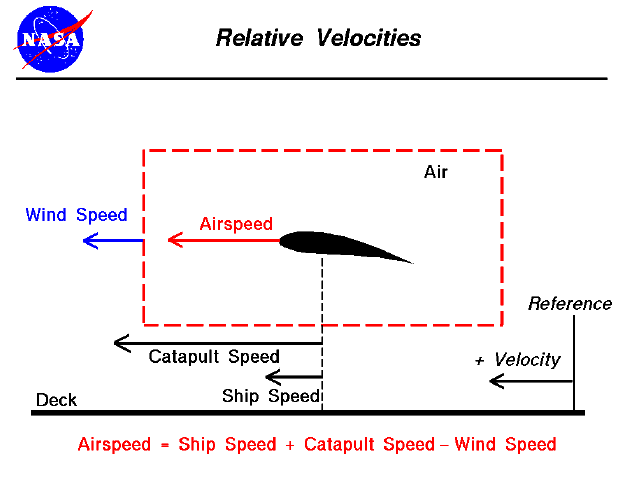

|
Airspeed
Problems
If so instructed by your teacher, print out a worksheet page for these problems. Beginner's Guide to Aerodynamics is a "textbook" of information prepared at NASA Glenn Research Center to help you better understand how airplanes work. Click Beginner's Guide Index to access the list of slides. Open the slide called Relative Velocities (with text) and read the explanation on how relative velocities are used to calculate airspeed required for aircraft launch.
In airport takeoff situations, the ground speed of the aircraft and the wind speed are the only factors in airspeed. The U.S. Navy has an additional variable. Its airports (aircraft carriers) move on the ocean at speeds that can be in excess of 35 mph. Airspeed in this unique situation is a sum of the ship's speed through the water, wind speed, and the speed of the aircraft over the deck of the ship provided by the ship's catapult. A catapult is like a huge rubber band and is used to propel an aircraft to higher speeds over a short distance in a few seconds. For more information on aircraft carriers and catapults, click on Aircraft Carriers (http://www.chinfo.navy.mil/navpalib/allhands/ah0197/pg08-09.html). Assume that a typical catapult can propel an aircraft from 0 to 150 mph in 2 seconds. The aircraft carrier problem is pictured graphically in the following illustration. (Note the airspeed equation at the bottom.) 
You are the Captain of the Aircraft Carrier USS Enterprise (CVN-65). Assume that the required airspeed for takeoff of an F-14 is 170 mph. Using the airspeed equation and information provided, complete the following table and answer the questions that follow. Assume that a positive wind velocity is in the direction of travel of the ship.
|
|
|
(Vs) mph |
(Vw) mph |
|
(>274 km/h) |
|
|
|
|
|
|
|
|
|
|
|
|
|
|
|
|
|
|
|
|
|
|
|
|
EDUCATOR RESOURCES | AERONAUTIC EDUCATIONAL RESOURCES | INTERNET ACCESS RESEARCH | ICING RESEARCH TUNNEL
BEGINNER'S GUIDE TO AERONAUTICS | FREE SOFTWARE | AERODYNAMICS INFORMATION | AERODYNAMICS PROBLEMS | PROPULSION INFORMATION |
PROPULSION PROBLEMS | FOILSIM INFORMATION | FOILSIM PROBLEMS | ENGINESIM INFORMATION | ENGINESIM PROBLEMS | ROCKETMODELER
AERONAUTICS LESSONS & ACTIVITIES | WIND TUNNEL WEB PAGES | AERONAUTS 2000 | VIDEOCONFERENCES WITH THE U.K.
Curator: Tom.Benson@grc.nasa.gov
Responsible Official: Kathy.Zona@grc.nasa.gov


